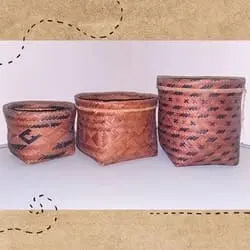BANIWA HANDCRAFT
This text was translated from a text written by André Fernando and Bonifácio (Baniwa Indians - President and Vice President of OIBI 1996).
 Sometime ago, Baniwa Indians (Community of Baniwa Indians
from Içana River, a tributary on the left side of the
Rio Negro, about 700 Km far from São Gabriel da
Cachoeira and 1,500 Km distant from Manaus) made their
own supplies according to their need to survive, for
hunting, fishing, dressing, celebrating cultural and
commemoration parties, built shelters and transportation
with materials taken from nature without damaging it. Indians never
deforest, they preserve the environment, caring and
maintaining it always in its original form. When the
Europeans arrived, they enjoyed the Baniwa Indians hand-crafts
and soon, exchanged it for merchandise.
Sometime ago, Baniwa Indians (Community of Baniwa Indians
from Içana River, a tributary on the left side of the
Rio Negro, about 700 Km far from São Gabriel da
Cachoeira and 1,500 Km distant from Manaus) made their
own supplies according to their need to survive, for
hunting, fishing, dressing, celebrating cultural and
commemoration parties, built shelters and transportation
with materials taken from nature without damaging it. Indians never
deforest, they preserve the environment, caring and
maintaining it always in its original form. When the
Europeans arrived, they enjoyed the Baniwa Indians hand-crafts
and soon, exchanged it for merchandise.
Since those times, the Indians have produced and sold to Colombia, FUNAI (Indian National Foundation), the Salesianos Missionary and others.
These are some examples of the their hand-crafts: bow and arrow for hunting and fishing; grater for grating manioc; Tipiti (a tube made by hand) for squeezing the manioc mass; baskets made of straw (Balaios) for storing the mass, flour, tapioca, Beiju (kind of sweet made of manioc), fruits etc. ...; sifter to sift the dry mass to make flour and Beiju, tapioca (Curadá); Cumatá specially for extracting the starch from the mass; Abano (straw fan) for turning and removing the Beiju from the clay made oven; stool for sitting; pestle to pound cook meat, smoked fish, pepper and other always toasted; bracelets; finger ring from the Tucumã (palm fruit) seed; Zarabatana (blow gun) especially for hunting birds; Japuruto, Cariçu and Flauta are musical instruments among others with their own specifically harmonious sound; ceramics plates, pots, vase for fabricating special alcoholic drinks and other ornaments for ceremony's, etc.
Ualaia and Uluda(Different baskets made of straw)
Both Baniwa Indian hand-crafts are used traditionally to store food like flour, beiju, tapioca and fruits. They can be made in large, medium or small size and made of a straw extract from a plant called Arumã do Mato. The process of production starts by going to the rising of a brook, catching the plant in the stable land, taking the size depending on the specie of the hand-craft wants to do, then it is necessary to scratch, wash, let them drying, after that to paint in black and red (ink made of urucum) mixing to varnish of wood to get an excellent bright, the next step after drying the paint is to take out the splints in the same size, to weave them doing some draws and fold as a basket called Ualaia and Uluda.
There are needed 150 units of Arumã to make a dozen of Ualaia and Uluda. The Arumãs, from which are extracted the splints, are cut close to the floor, so each time one Arumã is cut, two or three new small plants grow. The name of the craftsman are: Júlio Valentim and Arcindo Graciliano from Jandú Cachoeira village(Eñipani) close of the headquarters of OIBI (Indian Organization from Içana River), branch of FOIRN (Federation of Indian Organizations from Negro River).